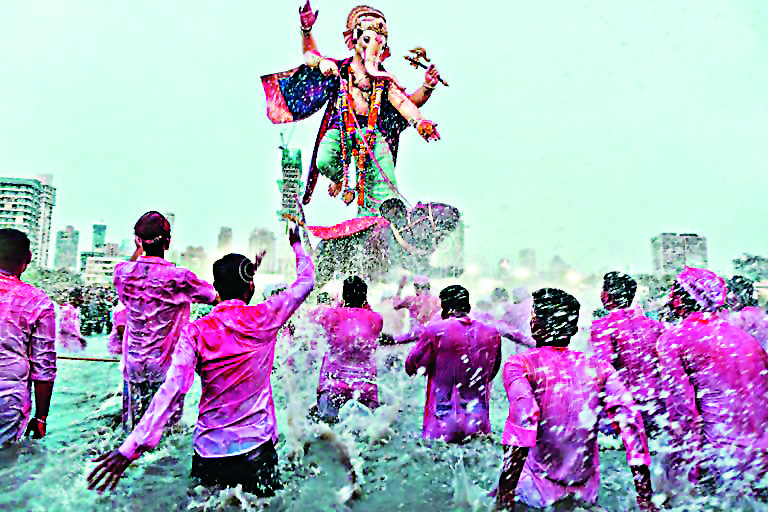We witness a range of creative and eco-friendly solutions as people bid adieu to their beloved Ganesh idols. Some bring home clay idols that dissolve harmlessly in water, while others have taken innovation to heart —creating idols entirely out of chocolate, which is later immersed in milk, allowing for a sweet, symbolic farewell. There’s also the rise of plantable Ganeshas, where the idol is embedded with seeds and can be planted in the soil after the festival.
Despite these creative approaches and government bans on harmful materials like Plaster of Paris (PoP), the shift to sustainable practices has been gradual. Many larger idols, especially in public celebrations, are still made from non-biodegradable materials due to cost and durability concerns.
It’s a heartbreaking sight to see the very Ganesh idol, once welcomed with music, dance, and modaks, lying amputated along the shore or riverbank — forgotten and neglected. After days of reverence and celebration, these idols lay abandoned in polluted waters, a poignant reminder of the environmental toll we overlook in the name of tradition.
Unfair farewell
Although the Ganesh Utsav is celebrated across India, its grandiosity can be felt majorly in Maharashtra, particularly in Mumbai and Pune. According to the Brihanmumbai Municipal Corporation (BMC), the city saw the immersion of around 62,000 idols in 2024, with many being immersed along the seashore and in specially created artificial lakes for Visarjan.
Despite efforts to manage environmental impact, the large-scale immersion poses significant challenges. The CSR Journal reports that after the immersion, the oxygen levels in the Arabian Sea near Mumbai drop by 50%, severely affecting marine ecosystems. The immersion of PoP idols exacerbates the problem, as they release harmful chemicals and heavy metals into the water, further endangering marine life.
Similar trends can be observed in other major cities like Pune and Hyderabad, where large numbers of idols are immersed annually. While there are increasing efforts to use eco-friendly materials, the environmental impact remains a pressing concern.
Environmentalists Pitch in
Kunal Rahangdale, an engineer and writer residing in Pune, whose literary work revolves around environmental issues, states, “When PoP idols are submerged, they transform into gypsum, increasing water hardness and damaging aquatic ecosystems.” He further explains how the chemical paints used to decorate idols contain toxic heavy metals like mercury, cadmium and lead, which seep into water bodies. “These metals bioaccumulate in fish, passing through the food chain and ultimately causing health issues for humans, from chronic illnesses to severe brain damage,” he adds.
Mumbai’s Gorai Creek experiences significant pollution spikes during and after Ganesh Visarjan, with tests revealing alarming increases in chloride and sulphate levels. Such conditions make the water uninhabitable for any life form, be it the aquatic animals and plants, or us human beings.
Let’s Talk Solutions
“It all starts with revisiting the guidelines made by the Central Pollution Control Board (CPCB) in 2020,” says Chaitanya Prabhu, founder of the non-profit organization Mark Your Presence. The CPCB document of 2020 essentially talks about identifying designated immersion spots to avoid overcrowding and pollution, state authorities helping local administrators in spreading awareness among the public over sustainable Visarjan practices, and banning or prohibiting PoP and toxic paints while creating idols.
According to Prabhu, the change must be made at the level of Ganesh pandals, where idols are created. “It is important for municipal corporations to step in and ask idol makers to completely stop making PoP idols, at least the smaller ones that are made for domestic households.”
He further mentions that at the Visarjan spot, people should also receive assistance in segregating biodegradable materials, which can safely be immersed, from non-biodegradable ones, which should be excluded from the immersion process.
Rituals and traditions like Ganesh idol immersion have been followed for generations and are deeply intertwined with people’s emotions and devotion, making them sensitive to change. Prabhu suggests that any efforts to introduce eco-friendly alternatives should be gradual and well-timed. “If the BMC wants to engage with the idol makers and artisans, they should initiate discussions well before the festival begins,” he advises.
Steps towards celebrating a greener Ganesh Utsav have not just been taken by Maharashtra and Karnataka. In 2019, the Karnataka Government banned PoP idols under the Environment Protection Act, of 1986 and established fines for violators. Similarly, Tamil Nadu, Telangana, and Andhra Pradesh have also introduced laws, focusing on promoting eco-friendly alternatives like clay idols and discouraging the use of PoP.
“Policies are in place, but the only place we fall flat is with their implementation,” says Prabhu. The concept of Ganesh Utsav, initiated by freedom fighter Bal Gangadhar Tilak in 1893, was originally a political strategy aimed at fostering unity among Indians under colonial rule. It provided a platform for public gatherings and collective action, spreading the message of strength in unity. Our fight today is to preserve the environment for future generations.
“Policies are in place, but the only place we fall flat is with their implementation,” says Prabhu. The concept of Ganesh Utsav, initiated by freedom fighter Bal Gangadhar Tilak in 1893, was originally a political strategy aimed at fostering unity among Indians under colonial rule. It provided a platform for public gatherings and collective action, spreading the message of strength in unity. Our fight today is to preserve the environment for future generations.

